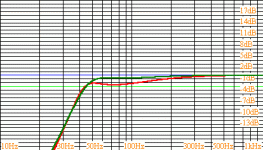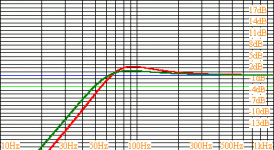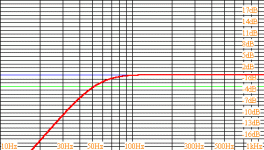I want to buy the woofers at this link http://cgi.ebay.com/ws/ebayISAPI.dl...RL=2&photoDisplayType=2#ebaylargephotohosting , but when I plug in the specs into WinISD (and others) I get a vented box with strange box calculations. Vbox = 3.5 liter, Tuning freq. = 57 Hz., Vent is 2 meters long. Is it because there's no place to put in the "mass added to cone" spec? I know I've seen a program that has a place to plug in this spec, but I forget which one it is. Does anybody know of any? What do you think? Are they just bad subwoofers?
Banned
Joined 2002
The speaker seems to have many of the same characteristics of the Peerless XLS 10". Only the company is not well-known like Peerless. The Peerless XLS 10 is something like $130 each.
The Peerless XLS series is basically designed for those who want to put a decent sized driver inside a very small box and get high output in the bass down to 50 Hz or so.
Below is a graph of the auctioned speaker, in red,and the Peerless XLS 10", in green. The box for both is a one half cubic foot enclosure, (14 liters), tuned to 42 Hz. Note the similarity, with the Peerless just edging out the auction speaker. The auction speaker dips just a little in the low range, but other wise holds it's own down to 42 hz-the lowest note the bass guitar normally plays, (with normal tuning).
In short, this is meant for a car where you want low but not necessarily super low bass in a small enclosure. And lots of it.
Normally, a 3" port is sufficient for a 10 inch speaker. Noisewise, a flared 2" port is roughly equivalent to a 3 inch port. A 2" port will tune a one half cubic foot box down to 42 Hz if it is 8" long.
I haven't used flared ports. Posters who have say that you should add an extra inch for the flares. So make that 9 inches with a 2 inch flared port.
Flares are available from Parts Express or Madisound, among aother places.
Here is the graph:
The Peerless XLS series is basically designed for those who want to put a decent sized driver inside a very small box and get high output in the bass down to 50 Hz or so.
Below is a graph of the auctioned speaker, in red,and the Peerless XLS 10", in green. The box for both is a one half cubic foot enclosure, (14 liters), tuned to 42 Hz. Note the similarity, with the Peerless just edging out the auction speaker. The auction speaker dips just a little in the low range, but other wise holds it's own down to 42 hz-the lowest note the bass guitar normally plays, (with normal tuning).
In short, this is meant for a car where you want low but not necessarily super low bass in a small enclosure. And lots of it.
Normally, a 3" port is sufficient for a 10 inch speaker. Noisewise, a flared 2" port is roughly equivalent to a 3 inch port. A 2" port will tune a one half cubic foot box down to 42 Hz if it is 8" long.
I haven't used flared ports. Posters who have say that you should add an extra inch for the flares. So make that 9 inches with a 2 inch flared port.
Flares are available from Parts Express or Madisound, among aother places.
Here is the graph:
Attachments
Thanks for the help. I think the subwoofer/speaker design programs that I used to design this speaker give me suggestions that seem to put the speaker in a box where it has the flatest frequency response. From the graph that you made and that I made later using WinISD (looks the same) the box for that wooker needs to be bigger (14 liter per woofer), with a lower tuning frequency (42 Hz). I don't think that I'll be going with a vented woofer in my car, I like sealed enclosures much better.
Want a nice 10 inch subwoofer for your car in that price range? One that works okay in a small sealed box?
Try the Peerless CSX 10".
I don't know if you know about Qtc-what the Q of a woofer is while in the box-but in a one half cubic foot box, the CSX 10" has a Qtc of 1.18. In a three quarters cubic foot box, (21 liters), it has a Qtc of .98.
Optimum Qtc is between .7 and 1.0. So the three quarter cubic foot box is within optimum range, the half cubic foot box is a little less than optimum-but still workable. Some might find it a bit boomy, most would find it all right.
In these compact boxes, don't forget to leave a little space for the space the speaker itself occupies. In these small boxes, that makes a difference.
About $60 each from Parts Express and Madisound, if you are in the US.
Available also in the UK and Australia.
Red is the half cubic foot, green is the three quarters cubic foot. box.
Try the Peerless CSX 10".
I don't know if you know about Qtc-what the Q of a woofer is while in the box-but in a one half cubic foot box, the CSX 10" has a Qtc of 1.18. In a three quarters cubic foot box, (21 liters), it has a Qtc of .98.
Optimum Qtc is between .7 and 1.0. So the three quarter cubic foot box is within optimum range, the half cubic foot box is a little less than optimum-but still workable. Some might find it a bit boomy, most would find it all right.
In these compact boxes, don't forget to leave a little space for the space the speaker itself occupies. In these small boxes, that makes a difference.
About $60 each from Parts Express and Madisound, if you are in the US.
Available also in the UK and Australia.
Red is the half cubic foot, green is the three quarters cubic foot. box.
Attachments
Oops. Forgot to mention that the CSX is 8 ohm. Most car amps are 4 ohm. A 4 ohm amp can only deliver half it's maximum power into an 8 ohm speaker.
Still not a bad choice. But before you buy you might want to look around to see if you can find anything like it in a 4 ohm version.
Actually, I have something in mind but I gotta run. I'll check it out and be back to you later.
Still not a bad choice. But before you buy you might want to look around to see if you can find anything like it in a 4 ohm version.
Actually, I have something in mind but I gotta run. I'll check it out and be back to you later.
Thanks for your help. Two 8 ohm subs is good thing. I might buy 2 used eclipse 8712.8 subwoofers (although I don't like to buy used woofers), but they seem to be nice woofers and they're a good match for my Soundstream 702 (700 watts @ 2/4 ohms). I don't understand why that amp puts out the same ammount of power at 2 and 4 ohms, but soundstream says it does. What was your idea?
The two I had in mind were the Blaupunkt PC 10 wi, available at Parts Express for $80, and the Blueprint 1001 for $81.
Of the two, the Blueprint is much the better, with a one way excursion of an inch. That is heavy duty air moving-and the more air is moved, the more bass can be produced. The Blaupunkt is not puny in the excursion department-a quarter inch, which used to tbe considered very good-but it is nowhere near Blueprint's class.
I personally have not tried the Blueprint drivers yet, but they are highly recommended by others on this website.
Blueprints are available here:
http://www.missiondigital.net/
Here is a picture of the Blueprint in a one half cubic foot sealed box. With the Blueprint's excursion, your big amp and normal cabin gain, you should be able to pump out big bass to below 30 Hz.
Of the two, the Blueprint is much the better, with a one way excursion of an inch. That is heavy duty air moving-and the more air is moved, the more bass can be produced. The Blaupunkt is not puny in the excursion department-a quarter inch, which used to tbe considered very good-but it is nowhere near Blueprint's class.
I personally have not tried the Blueprint drivers yet, but they are highly recommended by others on this website.
Blueprints are available here:
http://www.missiondigital.net/
Here is a picture of the Blueprint in a one half cubic foot sealed box. With the Blueprint's excursion, your big amp and normal cabin gain, you should be able to pump out big bass to below 30 Hz.
Attachments
Bose:
To produce bass at a large volume, you must move air. The greater the amount of air moved, the greater the SPL of an existing bass note, or the greater the ability of the woofer to produce a deeper bass note at the same volume.
Deeper bass notes require more air moved to produce the same SPL than higher notes.
Suppose you are playing a bass note at 100 Hz. The formula goes as follows:
A) To produce 100 Hz at 6 dB higher SPL, twice as much air must be moved. To produce the 100 Hz bass note at 6 dB lower SPL, half the air must be moved.
B) To produce a note half an octave below 100 Hz, (that would be 70 Hz), at the same SPL, the amount of air moved must be doubled. To produce a note a half octave above 100 Hz, (that would be 141 Hz), the amount of air moved must be cut in half.
The air moved is the area of the speaker's cone times it's excursion. So as you can see, a speaker with similar cone area but twice the excursion can produce bass notes 6 dB louder than the speaker with less excursion.
This is for a sealed enclosure.
To produce bass at a large volume, you must move air. The greater the amount of air moved, the greater the SPL of an existing bass note, or the greater the ability of the woofer to produce a deeper bass note at the same volume.
Deeper bass notes require more air moved to produce the same SPL than higher notes.
Suppose you are playing a bass note at 100 Hz. The formula goes as follows:
A) To produce 100 Hz at 6 dB higher SPL, twice as much air must be moved. To produce the 100 Hz bass note at 6 dB lower SPL, half the air must be moved.
B) To produce a note half an octave below 100 Hz, (that would be 70 Hz), at the same SPL, the amount of air moved must be doubled. To produce a note a half octave above 100 Hz, (that would be 141 Hz), the amount of air moved must be cut in half.
The air moved is the area of the speaker's cone times it's excursion. So as you can see, a speaker with similar cone area but twice the excursion can produce bass notes 6 dB louder than the speaker with less excursion.
This is for a sealed enclosure.
For a bass reflex, (ported) enclosure, there is a difference.
At the tuning frequency, the cone will be moving only 1/4 the travel that would be required to produce the same SPL from a sealed enclosure. That is the benefit of the port.
At one half octave above the tuning frequency, the cone only has to move half as far as it would have to move if it were to produce the same SPL in a sealed enclosure.
At one octave above the tuning freuency, the ported and sealed speakers are identical.
As for some idea of actual numbers, according to Small, (of Thiele-Small fame), it requires 6 cubic inches of air moved to produce 100 Hz at 112 dB, (@ 1Meter/1Watt, of course).
It requires 24 cubic inches to produce 112 dB SPL at 50 Hz. 50 Hz is one full octave under 100 Hz, therefore it requires 4 times the amount of air moved to produce the same SPL as 100 Hz.
50 Hz at 112 dB requires 24 cubic inches of air moved. It will take 12 cubic inches to produce 50 Hz at 106 dB. Remember, cutting the amount of air moved in half results in 6 dB less output at the same frequency.
You can use the guideline of 6 cu inches to produce 100 Hz at 112 dB to judge how loud and how low any speaker goes.
Is that clear? If it isn't, I can try again.
At the tuning frequency, the cone will be moving only 1/4 the travel that would be required to produce the same SPL from a sealed enclosure. That is the benefit of the port.
At one half octave above the tuning frequency, the cone only has to move half as far as it would have to move if it were to produce the same SPL in a sealed enclosure.
At one octave above the tuning freuency, the ported and sealed speakers are identical.
As for some idea of actual numbers, according to Small, (of Thiele-Small fame), it requires 6 cubic inches of air moved to produce 100 Hz at 112 dB, (@ 1Meter/1Watt, of course).
It requires 24 cubic inches to produce 112 dB SPL at 50 Hz. 50 Hz is one full octave under 100 Hz, therefore it requires 4 times the amount of air moved to produce the same SPL as 100 Hz.
50 Hz at 112 dB requires 24 cubic inches of air moved. It will take 12 cubic inches to produce 50 Hz at 106 dB. Remember, cutting the amount of air moved in half results in 6 dB less output at the same frequency.
You can use the guideline of 6 cu inches to produce 100 Hz at 112 dB to judge how loud and how low any speaker goes.
Is that clear? If it isn't, I can try again.
- Status
- This old topic is closed. If you want to reopen this topic, contact a moderator using the "Report Post" button.
- Home
- Loudspeakers
- Multi-Way
- "mass added to cone" I'm confused about it's meaning


